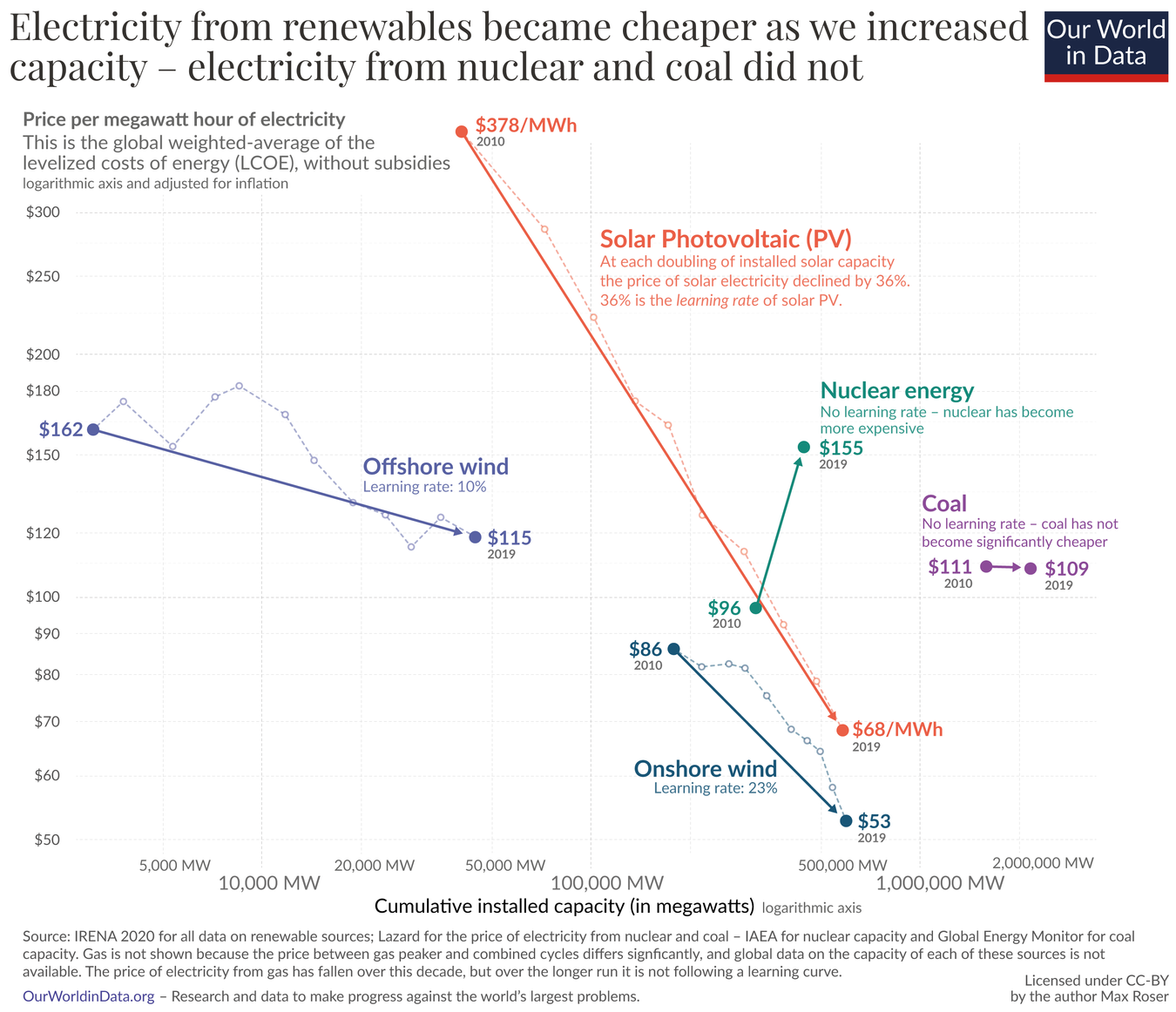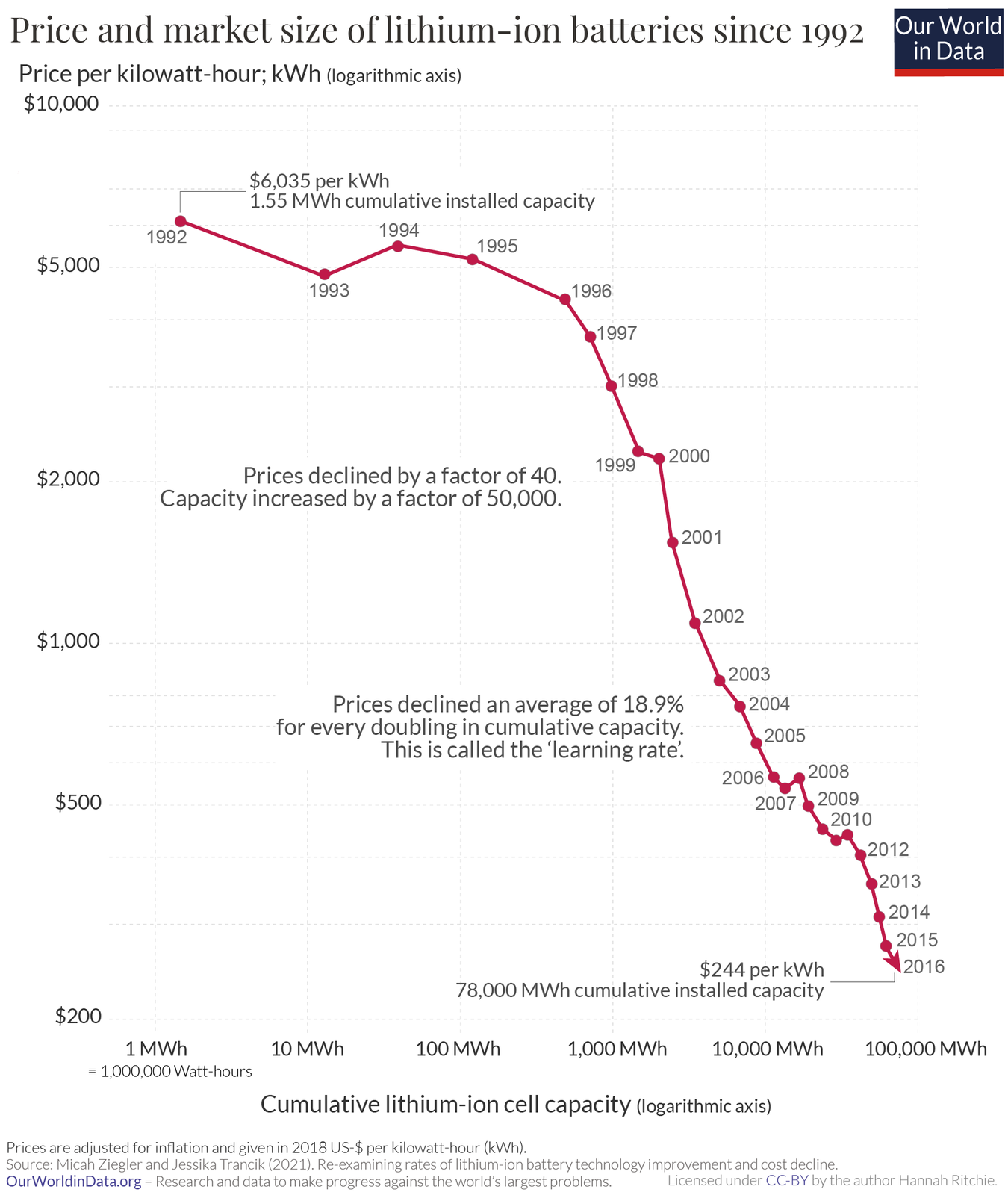Solar now being the cheapest energy source made its rounds on Lemmy some weeks ago, if I remember correctly. I just found this graphic and felt it was worth sharing independently.
It doesn’t matter how cheap solar is. Fossil fuels are still more profitable, because once a fossil fuel plant is built, it needs fossil fuel to run. You can’t do the same with sunlight. We literally cannot shift away from fossil fuels under the current profit driven model.
More profitable for fossil fuel companies, sure. And they will lobby to stay in business.
But no one needs fossil fuel companies. If you can sell 1 MWh power, that’s a fixed amount of income. If you have less costs to cover (what the graphic shows), then that’s more profit for you.
I’m speaking from an American perspective, but what you’re describing is part of the problem. Power companies are legally not allowed to make a profit from selling electricity here. They make a profit from the government giving them money to expand their services (this model was developed following world war 2 to encourage post war growth).
Again, under America’s current model, solar is not profitable, especially not for large corporations.
Hmm, interesting. Here in Germany, power companies are partially privatized and I always thought, whomever came up with that nonsense took inspiration from the turbo-capitalism in the USA. Apparently not.
Do they need to be profitable, though, in your model? It mostly sounds like a traditional public service, where the government could just tell them to use the money for solar…
And this shows exactly why investing in nuclear is not the answer every tech bro thinks it is. Its far cheaper to built renewable and more importantly far far far quicker.
I’m not sure it’s tech bros falling for the nuclear lie, it’s rather the wannabe rich invest boys in my experience.
The same people falling for NFTs
Is this just the cost per raw Watt produced?
Is it a fair comparison vs conventional fuel-based power (coal/nuclear)?
Ie: if you wanted to build a plant capable of producing continuously, 24 hours a day, you would need some multiple of solar panels to produce an excess during daylight, and storage.
Not that drastic drops in solar costs aren’t bad, just what would the cost-per-watt be if you had to power an average city on just solar for a year?
Well you’ll never get a “fair” comparison, because the environmental effects are never properly priced into the consumer price.
Cool…but where’s offshore wind?
I’m not quite sure, why it was left out of that graph, maybe they didn’t have matching data, but it is shown here (from the same source article):

Clearly nuclear is the future!
You do realise solar and wind gets pricier and pricier to integrate as the level of steerable capacity decreases?
What you are looking at here is “cost to install ‘rated capacity * load factor’”. A big part of the reason renewables are still cheaper is that we have a lot of backup steerable capacity, mainly in the form of gas plants in the west and coal plants everywhere else.
Renewables dump electricity onto the grid and then say “here, buy this!”. And the only reason the grid can respond and say “sure” is that it can tell the steerable gas and coal plants “turn off for a bit, these other plants are dumping a crap tonne of capacity onto the grid”.
Given the insane challenge in building enough storage and/or enough transmission capacity, you are going to need some steerable capacity beyond 70-80% renewable to continue to have cheap integration of intermittent renewables. Do you want that to be based on fossil fuel?
If we wanted to treat renewable capacity in the same way as we have treated other generators, we should say “I want steerable capacity between 0-1200 MW” from this field of wind turbines!”. That would force the currently externalised cost of guaranteeing generation onto the builders of renewables.
Right now, a lot of the real cost is hidden elsewhere in the grid - so it’s no wonder it looks so cheap.
Please don’t misread my comment as being against renewables, which we need a lot more of. I’m against crappy accounting.
However, your point also goes ageinst nuclear as this technology is not really steerable either. It produces a base supply. The lack of quick control of nuclear plant output even led to highways beeing lit in the night in Belgium (way back) to burn off the over supply.
The only technologies that can be quickly adjusted up and down are, to my knowledge, gas, hydro an battery storage. In a strictly renewable scenario (0 fossil, 0 nuclear fisson) it is imperative to have a lot of controllable reserves. Currently the plan is to use a mix of (pump) hydro, h2 and biomass powered gas plants and batteries in all shapes and forms (li-Ion, reflow, heat…) to be able to compensate peaks. This all is way more costly than just using wind and solar and hope supply will always be higher than demand.
For those interested I always recommend the yt channel “just have a think”. It has really awesome content about green technologies and the current state of affairs concerning the long and hard journey to 0 carbon.
That is honestly an urban myth that nuclear isn’t steerable. It’s not steerable in the second, but it is extremely steerable in the hour or the day, which is more than plenty given that renewables output change by the hour or day, rather than the second.
Yes it’s not frequency management - for that we have pumped storage and batteries. But it sure as shit is steerable enough for matching up with renewables. The wind doesn’t goes from Beaufort 6 to Beaufort 1 within a second.
This is a very interesting rabit hole you sent me into. Thanks for that!
Btw. I don’t get why you’re beeing downvoted. This is a civilised discussion and your comments are fair and well presented!I started searching a bit about steering nuclear.
So as usual it doesn’t seem to be quite so simple. I found a paper from 2017 (in German https://publikationen.bibliothek.kit.edu/1000102277/121070976 ). interesting parts translated through deepl/chatGPT:
"The operating manuals of the NPPs show that they [nuclear power plants] exhibit considerable flexibility:
In the range close to full load (above 80/90% of the nominal Power), the output can be increased or decreased by up to 10% of the nominal output per minute. In the upper load range (above 50/60 % PNenn), the power plants can be regulated at 3.8-5.2 %/min (for some reactor types, this is reduced to around 1 %/min if individual fuel rods are defective).For comparison: In lignite-fired power plants, this value is around 3 %/min, 4 %/min for hard coal-fired power plants and 6 %/min for natural gas steam or combined power plants 6 %/min. Only gas turbines, at 12 %/min, are significantly faster.
The lower load range (between 20 and 60%) is also possible, but in discussions with power plant operators it became clear that this has not yet been used in regular operation (apart from start-up and shutdown operations) and is not used in regular operation."
Also it seems that changing output puts stress on the whole systen. As well cited from the paper:
“Another factor is the number of cycles that the plants can undergo. Each load cycle stresses the material and, with frequent repetition, leads to signs of material fatigue. Nuclear power plants were designed for a specific maximum number of cycles during their construction. In the upper load range – for example, a reduction in power from 100% rated power to 80% and back (100-80-100) – coolant temperature and pressure hardly change. Therefore, the power plants are designed for up to 100,000 cycles of such nature. However, in the lower load range, the alternating stress on the components increases, and the maximum cycle count decreases significantly. The cycle 100-40-100, for instance, is allowed only 12,000 repetitions. For the cycle rated load-zero load-hot-rated load (100-0-100), a maximum of 400 cycles is specified. Assuming a plant lifespan of 40 years, this would correspond to 10 of these events per year.”So there seems to be considerable flexibility but you don’t want to shut it off completely or run below say 50% of nominal power. Also start-up times from 0 seem to be very long (1-2 days). This might not be the perfect match for running together with renewables, but there are definitively possibilities. Even when it’s windy and the sun shines, renewables would need to be shut down and the more expensive nuclear plant would run and burn fuel.
Therefore, my opinion still stands: the ultimate goal should still be 0 burning stuff, 0 nuclear.
Imagine how steep that line would be if the fossil fuel lobbies hadn’t been fighting it tooth and nail all these years
much more important: we’d be years ahead with storage technology.
Gotta keep prices high yo
It would be less steep because solar costs would have come down earlier.
That would make it steeper, no?
Pretty clearly shows why there’s no future for nuclear power.
Even for filling gaps in renewables, peaker plants are getting cheaper and don’t take 15 years to build.
I think that’s too simplistic of a view. Part of the high cost of nuclear is because of the somewhat niche use. As with everything, economies of scale makes things cheaper. Supporting one nuclear plant with specialized labor, parts, fuel, etc is much more expensive then supporting 100 plants, per Watt.
I can’t say more plants would drastically reduce costs. But it would definitely help.
The source article actually talks about this and measured data suggests nuclear cost actually went up, despite more capacity being built.
This is the first time, I’ve read this anywhere. More sources/studies would be really important. And there is lots of interpretations to be had on the why, but assuming the article isn’t completely off the mark, that’s cold, hard data suggesting that your (perfectly reasonable) assumption is actually wrong, after all.
Thanks, China.
And Germany!
The price of electricity produced is an interesting metric to look at but can be very misguiding alone without more data around it.
It like comparing the price of rain water compared to well water.
The same way that solar is cheaper than nuclear, rain water is much cheaper than well water, you just need a roof with a gutter to get rain water.
Does it means that we should stop using wells and rely only on rain water and use water only when it rains ? Or do we also want to have tanks, do we need a backup for when the tanks are empty ? …
Yeah, there may be situations/regions where even the cheapest solar isn’t good enough. But at some point, the cost difference does become an oppressive argument. Even at that price in 2019 already, you can use around 75% of your money to build storage or redundancy in multiple regions / with alternative renewables.
And this trend of cost reduction for solar will very likely continue, even if it might start levelling off at some point.
It’s frustrating seeing a graph showing the price of electricity going down while my utility prices go up. Does this take into account infrastructure cost?
The data stops in 2019. It’s completely outdated. The world is in chaos since covid. But anti nuke propagandists don’t care much about these “details”.
Hi, I’m a human being, not an “anti nuke propagandist”. I just checked, if there’s newer data, and well, there is, but no one seems to have formatted that in a way yet, which you or me would be willing to digest.
Personally, my impression has been that the solar industry was one of the industries that was pretty much completely unaffected by COVID, so I felt this graph was still perfectly relevant.
But even if it were strongly affected, I do not see why our technological progress in manufacturing, that we had in 2019, should evaporate with COVID.
There is inflation and a rise in natural catastrophes, but I feel like those would affect nuclear and others roughly proportional.Well, if you omit batteries then you are mostly true, although with covid there was a huge shortage of electronic components that would affect solar a lot, at least depending on where you live. Batteries is a big unknown now, because with all the demand for it, we simply can’t build enough batteries to feed all the grids with it.
Alright, yeah, good point with the batteries. I’m hoping the batteries in electric cars will double up as storage for the grid (already happening today), but also that there’s just enough redundancy with other renewables.
Are the renewables including cost of storage in this graphic? Batteries are a lot more needed with wind and solar since they aren’t always available.
Also, I’d imagine nuclear would enjoy a similar level of success if there were more countries willing to invest in nuclear.
As far as I understand the description at the top of the image, no, storage is not included. But if production costs are insanely low, that of course does leave plenty room for storage or redundancy. In particular, personally I believe the costs will continue on a logarithmic drop and we’re at the steep part of that, so even if it really is not the case today, I do expect solar production + storage to become cheaper in a not too distant future.
Also, as another graphic from the source article illustrates, battery costs are rapidly dropping, too:

They are aren’t. This is anti nuclear propaganda. It’s a waste of screen place. The data is outdated and completely manipulated.
So, what did you want me to do? Post the same graph, but black out the nuclear line, so no one can see it going upwards? I do find that data point interesting, too, but I would have posted this, even if it was just the solar dropping as it does.





